Katanga Airforce Fouga Cm-170 Magister
The Fouga Cm-170 Magister is a first generation two seater jet trainer. Its distinctive V-shaped tail makes it easily recognisable to most aviation lovers. While primarily operated as a trainer aircraft, the Magister was also used in combat as a close air support platform by 22 air forces. It saw action during the Six-Day War, the Salvadoran Civil War, the Western Sahara War, and the Congo Crisis. The Magister was also chosen by many aerobatics display teams, including the Patrouille de France, the Belgian Red Devils, Brazils Smoke Squadron, Austrian Silver Birds, the Luftwaffe flying school FlugzeugFuhrerSchule and the Irish Silver Swallows. The Fouga Magister was nicknamed "the whistling turtle" by the Belgian Air Force and the “whistling Rooster” by the Finns due to the motor whistling while in idle.
The aircraft could be equipped with two 7.5 mm or 7.62 mm nose machine guns and had two hard points for bombs or missiles.
The aircraft could be equipped with two 7.5 mm or 7.62 mm nose machine guns and had two hard points for bombs or missiles.
The Fouga Magister in AVIKAT service
In 1960, after the independence of Congo, the province of Katanga separated and became an independent republic. The President of Katanga, Moïse Tshombé, ordered 9 planes from Potez Air Fouga. Only three aircraft were delivered to Katanga at Luano (Elisabethville airfield). On February 15, 1961, the arrival of the three Katangese Fouga was announced by the "Daily Mail" of February 6, 61.
The six Fouga Cm-170 Magisters that were still to be delivered to the Katangese government were in Pointe Noire (Congo Brazaville) in October 1961. But following the UN embargo, the ship brought them back to Antwerp where they were taken care of by customs. These were later sold to the Irish Airforce.
In 1960, after the independence of Congo, the province of Katanga separated and became an independent republic. The President of Katanga, Moïse Tshombé, ordered 9 planes from Potez Air Fouga. Only three aircraft were delivered to Katanga at Luano (Elisabethville airfield).
On February 15, 1961, the arrival of the three Katangese Fouga was announced by the "Daily Mail" of February 6, 61.
The six Fouga Cm-170 Magisters that were still to be delivered to the Katangese government were in Pointe Noire (Congo Brazaville) in October 1961. But following the UN embargo, the ship brought them back to Antwerp where they were taken care of by customs. These were later sold to the Irish Airforce.
The six Fouga Cm-170 Magisters that were still to be delivered to the Katangese government were in Pointe Noire (Congo Brazaville) in October 1961. But following the UN embargo, the ship brought them back to Antwerp where they were taken care of by customs. These were later sold to the Irish Airforce.
AVIKAT Markings

Katangan Fouga KAT 91.
It crashed on June 23, 1961, during a maneuver over the old Eville runway.
Very few photographic documents exist of it.

Very few photographic documents exist of it.

Katangan Fouga KAT 93
Its engine was being repaired when the UN launched Operation "Rhum Punch" on August 28, 1961, which aimed to expel foreign personnel from the Gendarmerie and the Avikat. KAT 93 flew a few missions but was seized by the UN at the end of August 1961. 
The most common depicted AVIKAT Fouga
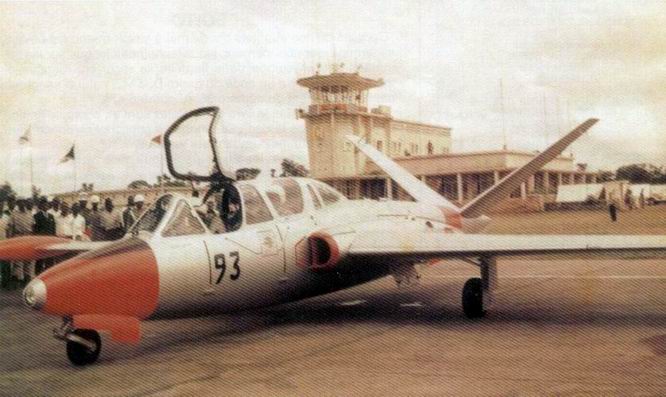
KAT 93 in front of the Luano control tower.
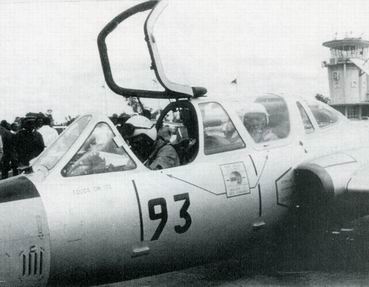
KAT 93 on the tarmac at Luano. President Moïse Tshombe sits in the passenger seat
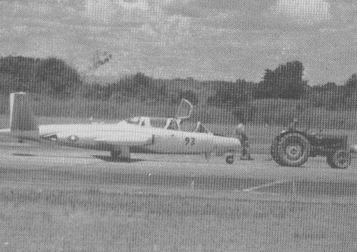
 Standing next to KAT 93 the Swedish Air Force Colonel Sven Lampell, head of ONUC air operations and head of the UN fighter wing which included the "F22" Saab J-29 squadron, the Iranian Sabre jet squadron and the Ethiopian Sabre jet squadron.
Standing next to KAT 93 the Swedish Air Force Colonel Sven Lampell, head of ONUC air operations and head of the UN fighter wing which included the "F22" Saab J-29 squadron, the Iranian Sabre jet squadron and the Ethiopian Sabre jet squadron.
Its engine was being repaired when the UN launched Operation "Rhum Punch" on August 28, 1961, which aimed to expel foreign personnel from the Gendarmerie and the Avikat. KAT 93 flew a few missions but was seized by the UN at the end of August 1961.
| The most common depicted AVIKAT Fouga |
| KAT 93 in front of the Luano control tower. |
 |
KAT 93 on the tarmac at Luano. President Moïse Tshombe sits in the passenger seat |

Katangan Fouga KAT 92
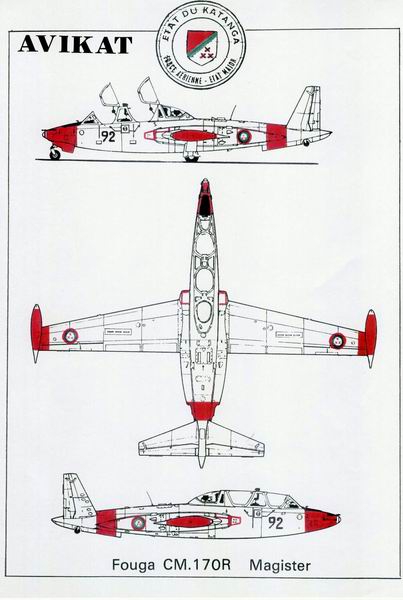
Markings for AVIKAT aircraft
Without a doubt, the most infamous of the Katangan Fouga Magisters, KAT 92 seen the most service and caused the most controversy. Kat 92 operated from September 14 to 19, 1961, against UN forces. Damaged by ground fire on the 18th but grounded while peace talks commenced and then came into effect on the 20th.
On the 3rd December 1961 it was damaged during an air attack, Indian UN Canberra bombers permanently grounded it at Kolwezi. Damaged, it was evacuated by rail on December 5, 1961, to Kisenge where it awaited replacement parts.
Thanks to this single training aircraft, based in Kolwezi, the Katangese "hunt" caused panic among the United Nations. The KAT 92 carried out rapid overflights of UN positions, dropping a few 50kg improvised bombs here and there. These interventions boosted the morale of the Katangese Gendarmerie and mercenary troops and sowed consternation among the ranks of the ONUC troops. The Fouga were an excellent means of psychological warfare against the ONUC soldiers and forced them to deploy air support. This Fouga also played a vital role in the attack on UN Kamina Airbase on the 15th, 16th, 17th and 18th of September destroying one DC4 on the ground and killing two UN pilots. Then the strafing and bombing of the Irish at Jadotville between the 13th and 17th. During at ground attack on the Kamina Airbase on the 18th it received damage.
José Magain “the lone Prowler”The pilot of the Fouga 92 was the Belgian José Magain who had flown with the Belgian Air Force. Joseph Delin the commander of Kolwezi airbase accompanied him as co-pilot on several missions including the staffing of Jadotville But when the journalists and photographers showed up in Kolwezi, José Magain disappeared… because no one could know that he had piloted the Fouga Magister. In reality he should no longer have been in Katanga and should have returned to Belgium on August 28, 1961, just like the other members of Avikat expelled by the UN (Operation “Rumpunch 27th August - October 1961”).
Armament for KAT 92, originally armed with 7.50 mm guns and ammunition, it was re-chambered for 7.62 caliber as ammunition was readily available. for bombing ground attack missions required manufacture of 50 kg bombs from mortar rounds and a primitive dropping and aiming system organized with the means at hand. The Fouga KAT 92 flew about 50 missions, claiming a UN DC-6, a DC-4, a DC-3, a dozen trucks, strafing the positions Jadotville, and a UN radio installations was destroyed at Kamina. The end of each of these missions was punctuated by a message to the control tower manned by the UN: "See you soon, gentlemen; I will be happy to come and see you again!"

“The Ghost Sqaudron” a dummy aircraft on Kolwezi runway
| Markings for AVIKAT aircraft |
Without a doubt, the most infamous of the Katangan Fouga Magisters, KAT 92 seen the most service and caused the most controversy. Kat 92 operated from September 14 to 19, 1961, against UN forces. Damaged by ground fire on the 18th but grounded while peace talks commenced and then came into effect on the 20th.
On the 3rd December 1961 it was damaged during an air attack, Indian UN Canberra bombers permanently grounded it at Kolwezi. Damaged, it was evacuated by rail on December 5, 1961, to Kisenge where it awaited replacement parts.
Thanks to this single training aircraft, based in Kolwezi, the Katangese "hunt" caused panic among the United Nations. The KAT 92 carried out rapid overflights of UN positions, dropping a few 50kg improvised bombs here and there. These interventions boosted the morale of the Katangese Gendarmerie and mercenary troops and sowed consternation among the ranks of the ONUC troops. The Fouga were an excellent means of psychological warfare against the ONUC soldiers and forced them to deploy air support. This Fouga also played a vital role in the attack on UN Kamina Airbase on the 15th, 16th, 17th and 18th of September destroying one DC4 on the ground and killing two UN pilots. Then the strafing and bombing of the Irish at Jadotville between the 13th and 17th. During at ground attack on the Kamina Airbase on the 18th it received damage.
José Magain “the lone Prowler”
The pilot of the Fouga 92 was the Belgian José Magain who had flown with the Belgian Air Force. Joseph Delin the commander of Kolwezi airbase accompanied him as co-pilot on several missions including the staffing of Jadotville But when the journalists and photographers showed up in Kolwezi, José Magain disappeared… because no one could know that he had piloted the Fouga Magister. In reality he should no longer have been in Katanga and should have returned to Belgium on August 28, 1961, just like the other members of Avikat expelled by the UN (Operation “Rumpunch 27th August - October 1961”).Armament for KAT 92, originally armed with 7.50 mm guns and ammunition, it was re-chambered for 7.62 caliber as ammunition was readily available. for bombing ground attack missions required manufacture of 50 kg bombs from mortar rounds and a primitive dropping and aiming system organized with the means at hand. The Fouga KAT 92 flew about 50 missions, claiming a UN DC-6, a DC-4, a DC-3, a dozen trucks, strafing the positions Jadotville, and a UN radio installations was destroyed at Kamina. The end of each of these missions was punctuated by a message to the control tower manned by the UN: "See you soon, gentlemen; I will be happy to come and see you again!"
 |
| “The Ghost Sqaudron” a dummy aircraft on Kolwezi runway |
Hammarksjöld “affair”
. 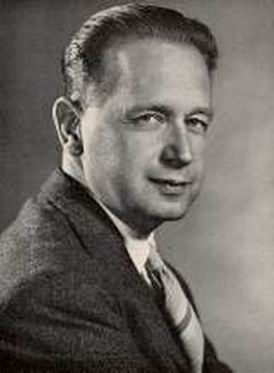
The event that has attracted the most attention regarding KAT 92 is the crash of Dag Hammarksjöld's DC-6 on September 17, 1961. Dag Hammarksjöld was the Secretary-General of the United Nations and was dispatched to the Congo to try to resolve the crisis.
On the evening of September 17, his plane took off from Leopoldville for N'Dola. He was going there with the aim of meeting Moïse Tshombé...… The DC-6, "Albertina", never landed in N'Dola and crashed around midnight on a hill near N'Dola. Initially, the Fouga Magister KAT 92 was accused of having shot down the plane of the Secretary General of the United Nations, later it is thought a De Havilland Dove that did have night flying ability dropped mortar bombs onto the aircraft.
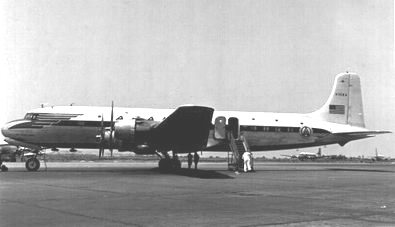
DC-6 “Albertina” registered SE-BDY which transported UN Secretary General Dag Hammarksjöld on September 17, 1961.
The international commission of inquiry sent to the scene by the UN to analyze the causes of the crash concluded that the reasons were certainly accidental. This same international commission from Rhodesia went to Kolwezi on October 20, 1961 to monitor the activity of the Fouga KAT 92 on the day of Mr. Hammarksjöld's death. On site, Major DELIN proved to them that the aircraft's autonomy was insufficient to reach N'Dola and, what's more, the Kolwezi airfield was not equipped for night flights. This exonerated (officially), at the same time, the Belgian pilot of the Fouga, Joseph Delin... (unofficially) we have since known that it was José MAGAIN who was the jet's assigned pilot!
CheersMatt
. 

On the evening of September 17, his plane took off from Leopoldville for N'Dola. He was going there with the aim of meeting Moïse Tshombé...… The DC-6, "Albertina", never landed in N'Dola and crashed around midnight on a hill near N'Dola. Initially, the Fouga Magister KAT 92 was accused of having shot down the plane of the Secretary General of the United Nations, later it is thought a De Havilland Dove that did have night flying ability dropped mortar bombs onto the aircraft.
 |
| DC-6 “Albertina” registered SE-BDY which transported UN Secretary General Dag Hammarksjöld on September 17, 1961. |
The international commission of inquiry sent to the scene by the UN to analyze the causes of the crash concluded that the reasons were certainly accidental. This same international commission from Rhodesia went to Kolwezi on October 20, 1961 to monitor the activity of the Fouga KAT 92 on the day of Mr. Hammarksjöld's death. On site, Major DELIN proved to them that the aircraft's autonomy was insufficient to reach N'Dola and, what's more, the Kolwezi airfield was not equipped for night flights. This exonerated (officially), at the same time, the Belgian pilot of the Fouga, Joseph Delin... (unofficially) we have since known that it was José MAGAIN who was the jet's assigned pilot!
Cheers
Matt
Very interesting Matt.
ReplyDelete